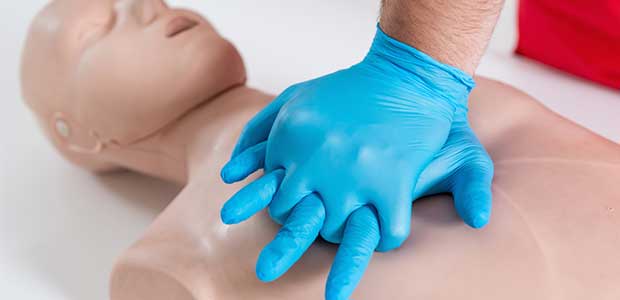
How the Pandemic is Reshaping Common Training and Procedures
As workers trickle back into the workplace, it is important to revise daily, weekly, monthly and annual procedures to mitigate the risk of the coronavirus, including AED/CPR training.
- By Sydny Shepard
- Oct 01, 2020
With heart disease and COVID-19 being two of the top three leading causes of death in 2020, it is important to take a look at your current procedures for defibrillators, AEDs and CPR. The way you go about training employees, or even procedures that need to be carried out in the event that an emergency does occur, needs shift to mitigate the threat of COVID-19. In this article we will discuss ways to put infectious disease control at the forefront of your safety plans without overlooking workers’ heart health.
Expect the Unexpected
When it comes to creating safety plans and procedures, OSH professionals often focus on finding recognized hazards such as clearly preventable injuries and illnesses. While these hazards certainly warrant attention, it is the unexpected injuries, such as sudden cardiac arrest, that workplaces need to be fully prepared for.
According to the American Heart Association, more than 350,000 EMS-assessed out-of-hospital cardiac arrests happen in the United States each year, and unfortunately about 90 percent of these cases die without immediate medical attention or intervention from bystanders. These statistics highlight the need for proper training and emergency devices on-hand as coworkers are often the first responders to sudden cardiac arrests in the workplace.
With workers trickling back or new workers being introduced into your working environment, now is a great time to reintroduce AED and CPR training. This training will not look like it used to however, there are several things safety directors must keep in mind when going through current policies and procedures to mitigate the risk of spreading COVID-19.
Shifting Policies and Procedures
Here are a few ways that this training might shift to ensure workers have the best and most reliable information possible in their toolbox, but won’t put their health at risk.
Gathering. Normally, a First Aid or CPR training class would happen with a group of workers and one or more instructors. In the age of the Coronavirus, you might need to shift from in-person training to online training since having employees gather in one room in close proximity might increase the risk of COVID-19’s spread. There are several online resources to help bulk up your virtual training plans.These could be videos that you disseminate to your workers, or an online class that employees can complete during the work day.
If you wish for employees to meet together for training, do so in smaller groups and require all employees to wear a face covering of some sort. Ensure that those participating in the training can social distance from the instructor and if training equipment is used, be sure it is disinfected between each person using it.
Hands-Only. According to a FAQ sheet from the AHA released in of March 2020, hands-only CPR has been shown to be as effective as conventional CPR in many cases. AHA recommends a face mask or cloth covering the mouth and nose of the rescuer and/or victim as it may reduce the risk of transmission to a non-household bystander, such as a colleague at work.
Hands-only CPR has two easy steps:
Call 911 if you see someone suddenly collapse.
Push hard and fast in the center of the chest to the beat of a familiar song that has 100 to 120 beats per minute.
People feel more confident performing Hands-Only CPR and are more likely to remember the correct rate when trained to the beat of a familiar song. Song examples include “Stayin’ Alive” by the Bee Gees, “Crazy in Love” by Beyoncé featuring Jay-Z, “Hips Don’t Lie” by Shakira or “Walk the Line” by Johnny Cash.
AHA has provided a 90-second instructional video on hands-only CPR, which can also serve as a natural introduction to CPR, at heart.org/handsonlycpr.
The Use of AEDs. The use of an AED is the third step to survival in the instance of a sudden cardiac arrest, with the first two steps being a call to 911 and beginning CPR immediately. It is a great option to use in conjunction with hands-only CPR to increase the chances of survival.
During a cardiac arrest, the electrical activity in the heart is disrupted. The heart, brain and other vital organs aren’t receiving enough oxygenated blood making each and every second essential to survival. Unfortunately, less than half (45.7 percent) of cardiac arrest victims get the immediate help they need before emergency responders arrive, in part because medical services take, on average, between four and 10 minutes to reach someone in cardiac arrest.
Survival from cardiac arrest doubles when a bystander applies an AED before an emergency responder arrives, according to 2018 research published by AHA. This finding emphasizes that bystanders—or for our purposes, coworkers—make a critical difference in assisting cardiac arrest victims before emergency responders can get to the scene.
An additional benefit of utilizing the AED properly is that the rescuer can both were proper PPE when aiding the victim, reducing the risk of a COVID-19 transmission. Check to see if your company has an AED, that it is functional and is positioned appropriately on a wall in a common space.
Covering All the Bases
The good news is 90 percent of employees would take a First Aid and CPR+AED training class if employers offered it. Ensuring employees know how to react to a sudden cardiac arrest with appropriate Coronavirus-approved methods could save the life of someone in your office and help to mitigate the spread of COVID-19.
This article originally appeared in the October 2020 issue of Occupational Health & Safety.